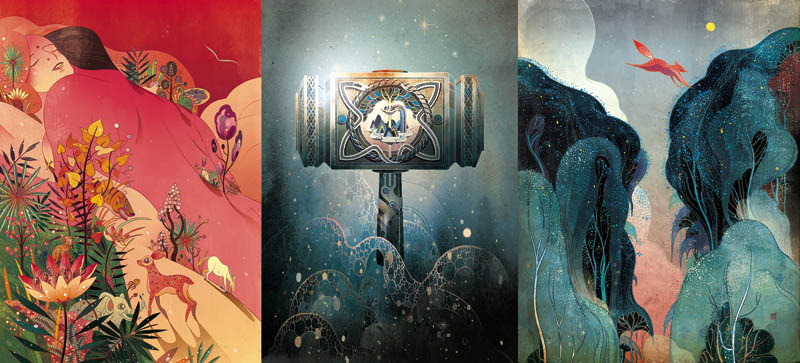Spotlight on: Victo Ngai, Artist

Victo Ngai is a Los Angeles based illustrator from Hong Kong, graduated from Rhode Island School of Design. “Victo” is not a boy nor a typo, but a nickname derived from Victoria – a leftover from the British colonization.
Ngai’s work appears in advertising, packaging, magazines, books, newspapers and animation, her clients include The New York Times, The New Yorker, Apple, Prophecy Wines, Johnnie Walker, American Express, Lufthansa Airline, General Electric, Tor, WW Norton, Penguin Random House, Simon & Schuster, NBC and Dreamworks.
Ngai’s work has received many honors including Forbes 30 Under 30 (Art & Style), The One Club Young Guns 16, Society of Illustrators NY Gold and Silver medals, Spectrum Gold and Silver Medals, Hugo Award and World Fantasy Award nominations, and many more.
What is the appeal of working in the field of SF and fantasy art? Who were your influences; was there a particular artist or artists who drew you in?
I have been a huge fan of science fiction and fantasy for as long as I can remember, my first SF/F art encounter was with Alan Lee’s The Lord of the Rings. As beautiful as Tolkien’s words were, it was Lee’s images which really brought Middle-earth alive for me. When I imagine Minas Tirith or Moria now, it’s Lee’s Minas Tirith and Moria I see, and now I find myself to be in the same incredible privileged position to bring my visions to the world. Sometimes it feels unreal.
Talk a bit about one of your most interesting cover projects. What’s it like to visually interpret a story? How do you go about transforming what’s on the page to what’s on the canvas?
The paperback cover for Neil Gaiman’s Norse Mythology was quite an unusual project for me. It was my first time working on a book which already has a cover – one from the great Sam Weber no less. So that’s definitely some big shoes to fill. I had to do something featuring Mjolnir (Thor’s hammer) in a similar composition as the hardcover. It was my first cover that didn’t feature any characters or scenes. I focused on designing Mjolnir with elements from the tales, such as Asgard, Midgard, the Rainbow bridge, and many more. What excited me the most with Norse Mythology was its cyclic view on time, and I found it intriguing that the world was both created and destroyed in big floods. That inspired the idea of the hammer emerging/submerging from/into an ocean. One thing I love about telling a story in one frame instead of in sequences, is that different readers are allowed to have totally opposite reads on the same image. In this case, some may think the hammer is lost in the sea after the Gods have lost their final battle, while others can imagine its rising from the water.

What was the best piece of advice you’ve ever received as a professional artist? And is there a piece of advice you wish you’d received that you’d like to pass on to other aspiring artists?
I was struggling to find my voice in college. I found myself attracted to a lot of different artists, but couldn’t decide which “look” was right for me. For a while, I was imitating my heroes, and every week I would bring a work inspired by a different artist to class. I was going nowhere. Then one day my teacher and mentor Chris Buzelli looked at my sketch book and told me that my doodles were way more genuine and therefore more interesting than the “serious” pieces I was making for homework. He told me, “Style is overrated – it’s merely a habit of drawing. Everyone has a unique style because everyone is unique.” This piece of advice was a eureka moment for me, and made me realized I needed to look inward instead of outward for the special little something that would make my art mine.
Is there something about what you do as an artist working in the SF field, or an upcoming project, that you’d like to tell our readers about?
I am currently working on my second children’s book, written by Muon Van. The story is based on the author and her family’s experience fleeing Vietnam in the early ’80s. The writing is very lyrical and reflective, and I believe it to be an important book to bring into the world, especially in our current time. I really hope to do it justice – look for it in 2020!
Photo of Victo Ngai by BKWLD, Jonathan Joiner
This spotlight and more like it in the January 2019 issue of Locus.
 While you are here, please take a moment to support Locus with a one-time or recurring donation. We rely on reader donations to keep the magazine and site going, and would like to keep the site paywall free, but WE NEED YOUR FINANCIAL SUPPORT to continue quality coverage of the science fiction and fantasy field.
While you are here, please take a moment to support Locus with a one-time or recurring donation. We rely on reader donations to keep the magazine and site going, and would like to keep the site paywall free, but WE NEED YOUR FINANCIAL SUPPORT to continue quality coverage of the science fiction and fantasy field.








